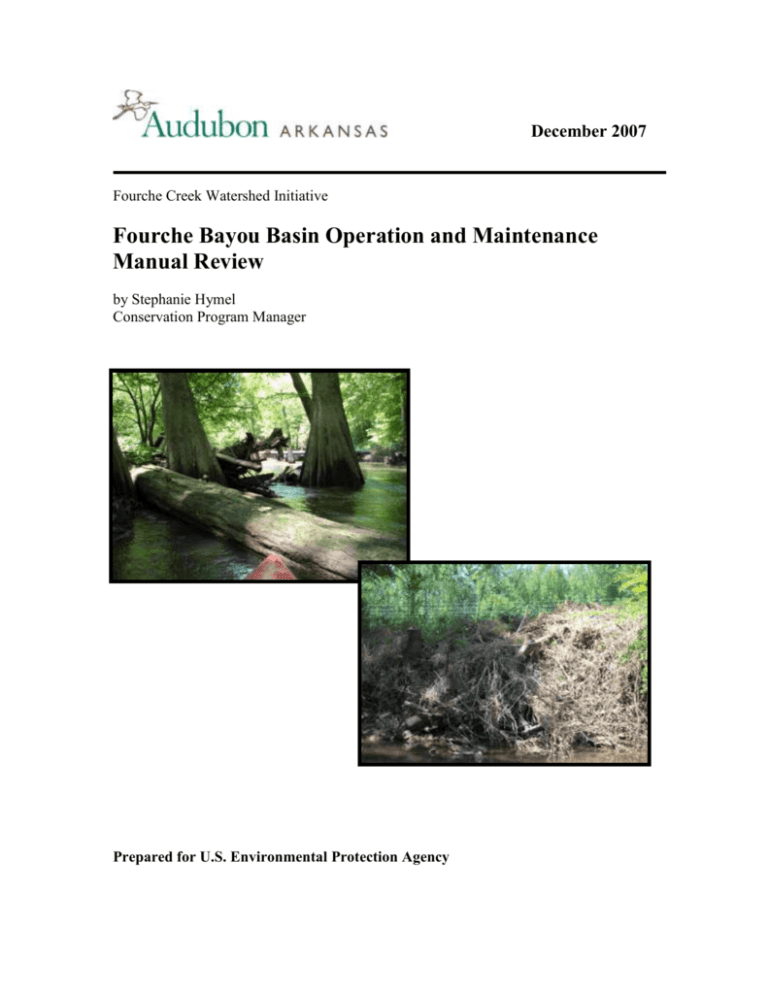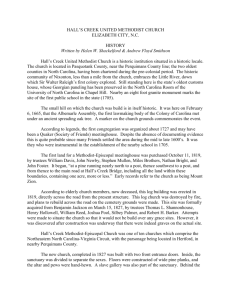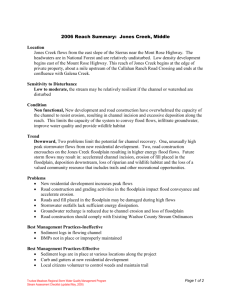Fourche Creek Operations and Maintenance Manual Review
advertisement

December 2007 Fourche Creek Watershed Initiative Fourche Bayou Basin Operation and Maintenance Manual Review by Stephanie Hymel Conservation Program Manager Prepared for U.S. Environmental Protection Agency Acknowledgements This work is made possible through a grant from the US Environmental Protection Agency as a part of its Targeted Watersheds Initiative and through the continued support of Audubon Arkansas Partners and Donors. The Targeted Watersheds Grant Program is an EPA program designed to encourage successful community-based approaches and management techniques to protect and restore the nation's waters. Introduction The Fourche Bayou Basin Project was authorized by Section 401(a) of the Water Resource Development Act of 1986 (Public Law 99-662). The purpose of the project is flood control. Through a local cooperation agreement, the United States Army Corps of Engineers (USACOE) turned over operation and maintenance of the project to the City of Little Rock, Arkansas. The Operation and Maintenance (O&M) Manual currently in use was put together in 1998. After reviewing the O&M Manual, Audubon Arkansas sees several areas where the procedures can be improved upon and/or changed to reflect more up-to-date Best Management Practices (BMPs) and to address problems within the Fourche Creek Watershed. The following are a list of recommendations. Operation In the manual, Section 8, Operation, a. Guidance (1) states that, “Specific items of operation and maintenance are enforcement of flood plain ordinances to prevent encroachments that would reduce floodway and channel capacities and maintenance of channel capacity by removing sediment and controlling growth of vegetation….Erosion of the channel side slopes from rainfall and overbank drainage must also be controlled and repaired as needed.” The current practice in use to control vegetation is mowing down to the base of the stream channel. While this may remove vegetation, it contributes to the amount of sediment entering the creek and its tributaries via erosion. Vegetation is removed, but no effort is made to repair and stabilize streambanks. More “no mow zones” should be established along the creek and these areas should, preferably, be native vegetation. Even small buffer strips would lessen the impact of runoff. Streambank erosion decreases the bank level, decreases the channel depth and results in more flooding. Streambank erosion off Springer Avenue Scouring of the stream bottom by heavy equipment should also be avoided. Scouring or dredging down to bedrock destroys aquatic habitat and increases the velocity of water flowing through the channel. While increasing water flow during storm events may be a way of alleviating flooding, it destroys habitat, causes bank scour and reduces the carrying capacity of the waterbody. Dredging, channelization and construction of concrete trapezoidal channels shortens the lag time between rainfall events and peak flow events; greatly increases peak flow; and total run-off is compressed into a shorter time interval, creating favorable conditions for intense flooding. Channel capacity can be increased by having gently sloped streambanks and restoring the natural meander of the waterbodies. This slows down flow which reduces scour and erosion and the creek would be able to handle more stormwater. Exposure of bedrock after dredging on Rock Creek Increased turbidity due to heavy equipment in stream channel and removal of vegetation Instream vegetation, rocky substrate and some sediment are necessary for aquatic life and they also slow down the flow of water during storm events. Reducing the storm flow with vegetation would allow additional infiltration times and removal of suspended sediments from the stormwater without detrimentally affecting the flood control capacity of the creek. Current maintenance practices are in direct opposition to preventing erosion of the channel side slopes as outlined in the manual, since removing material from the stream channel causes headcuts and exacerbates bank erosion. Allowing vegetation growth can prevent riverbed aggradation by binding soil, reducing runoff and thus reducing or eliminating the need to dredge down to bedrock. Lack of vegetative cover and bank undercut along Fourche Creek Also in Section 8a, mention is made of development within the protected area. The section states, “Local interests are required to consider the degree of protection afforded in connection with future development within the protected area. These requirements shall include adoption of such regulations that may be necessary to ensure compatibility between development and the protection levels.” Clarification should be made on what constitutes development. The City currently has multiple golf courses and parks in the floodplain. The management of these currently contributes to stream bank erosion and an increase in runoff. Frequent mowing of streambanks and erosion around check-dams are two common causes of problems on city owned property. Maintenance Under Section 10b. Maintenance 1 & 2, there is a provision for clearing the channel of weeds, trees taller than 18 inches, trash and debris; and a provision for ensuring the channel is not restricted by deposition of waste materials, structures or other encroachments. The City of Little Rock does not currently conduct trash clean-ups along Fourche Creek. Many log jams and trash dams have formed along the creek and obstruct water flow. These jams can cause braided stream channels which could actually increase flooding in the area. Tires, appliances, cars, drums and other types of waste thrown into the creek could potentially release hazardous materials into the creek. Stream cleanups can potentially prevent pollutants from being released into the waterbody. Routine maintenance, inspections after storm events to identify problem areas, and installing storm grates to reduce the amount of trash entering Fourche Creek would help to alleviate this problem and bring the City back into compliance with the provisions of the Agreement. Trash and debris dam along Fourche Creek obstructing flow Illegal dump site along Fourche Creek In the same section, Maintenance, 4. instructs that banks are not damaged by rain or wave wash and that sloughing of banks has not occurred. Streambank erosion has occurred all along Fourche Creek and its tributaries. Proper streambank management and no-mow zones along streambanks would help remedy this issue. Log jams can redirect water flows causing undercuts, headcuts, etc…that contribute to sloughing of banks. One effect of streambank erosion along Fourche Creek “Measures are taken to promote the growth of grass on top of bank and channel side slopes,” is listed in Maintenance 5. This is somewhat ambiguous and should be clarified. An example is downstream of Springer Blvd. on Fourche Creek where grass is not the most effective erosion control vegetation. Upstream of Springer, cypress trees and wetland vegetation are more effective at preventing erosion than grass. Specific erosion control best management practices should be determined for each site instead of a “onesize-fits-all” approach. A beautiful stretch of Fourche Creek upstream from Springer Ave. Number 7 & 8 are repetitive and go back to the previous recommendation of more thorough and expedient maintenance and inspection of Fourche Bayou. These two directives state that immediate steps should be taken to repair damage and remedy adverse conditions, and that adequate measures are taken to ensure trash, drift or debris does not accumulate on or near the banks. Several sections of the manual refer to controlling vegetation by use of tractor mowers, hand labor and/or chemicals in the most efficient manner. Chemical use along the streambank should be discouraged. This could possibly result in water quality violations depending on the chemical used. The Fourche Bayou Basin should be surveyed to determine the best method possible for controlling vegetation and not have a “one-sizefits-all” approach. A surveillance program is required for the Fourche Bayou Basin Project. The O&M Manual calls for a project stage monitoring system that will observe stream stage and rainfall at selected locations throughout the basin. Maximum stream stages should be recorded after each storm event and if the stream height begins to trend upward, the channel should be inspected for debris and/or man-made restrictions. It is uncertain whether or not these observations have been made, where the monitoring stations are located and what, if any, remediation has been performed after storm events. Another consideration may be to revise flood maps and discourage development in or near the current floodplain. The Local Cooperation Agreement requires the Local Sponsor to publicize floodplain information in the area of concern and provide this information to zoning and other regulatory agencies for guidance and adoption of ordinances to prevent unwise development and to ensure project compatibility. This should be adhered to more closely, especially along tributaries of Fourche Creek where numerous channelization and floodplain filling projects have been allowed. This provision relates back to page 13, item 7 of the Manual. The City’s interpretation of development and protection should be made clear and should be disseminated to the departments in charge of development and protection of Fourche Bayou. Summary Lack of maintenance in some areas, and unsuitable maintenance in other areas, have created problems along Fourche Creek that can be remediated through simple changes. Routine trash and debris clean-up will alleviate damming of the creek. There are many volunteer groups throughout the city that might be willing to help with this effort. Identifying areas that contribute the most trash and installing storm grates in these areas is another option. Planting native grasses, wildflowers and trees along streambanks would deter erosion and improve habitat throughout the watershed without interfering with storm flow. Reducing the amount of mowing and establishing “No Mow” zones along streambanks would also reduce erosion. These measures would also save the city money by reducing maintenance costs. There are several funding sources the city could pursue to cover the costs of establishing vegetative cover. Development within the floodplain should be discouraged where possible. If development does occur, current Best Management Practices should be followed to ensure protection of the streambank and establishment of buffer zones. Fourche Creek is an asset to the City of Little Rock that has been under utilized. By improving instream and streambank habitat, and improving the aesthetics of the creek, Fourche Creek can be a source of income and recreational opportunities for the citizens of Little Rock and further the goal of a “City in a Park.”






